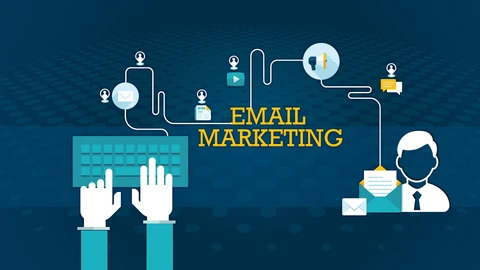5 Top Secrets to Campaign Optimization
5 Top Secrets to Campaign Optimization
Your campaign is now up and running and you are ready to make adjustments as necessary to improve the performance. Yup! It is always vital to keep an eye on your email campaigns in order to get the most out of your campaigns. Just imagine, you are setting up a marketing programmatic campaign and going down your digital checklist before the campaign goes live! You might have to analyze whether you have targeted a specific set of audiences? Have you set up the bid, uploaded the creative, and chosen the right inventory? Just check all these and if done, you are all just ready to sit back and watch the flows in.

Campaign Optimization: An introduction!
Campaign optimization is literally meant to be optimizing your campaign for success and maximizing the chances of winning auctions, user engagement, and serving impressions.
- Indeed, marketing campaign optimization is the ultimate key to turning out the strategy into a powerful marketing machine
- Though it is an effective means, still there are many marketers struggling to stay on top of optimization practices.
- Despite the best intentions, marketing campaigns are like a tiger having the form of something grand.
Campaign optimization: strategies
Once your campaign is live and you have decided what you want to achieve with it, then it’ll definitely be a challenge figuring out how to start the campaign by optimizing the process. Here are some strategies for campaign optimizations and you can explore them below:
- Data – Data is the first thing needed to be optimized based upon the amount of data (i.e.) the size of the content needed to make the informed decision.
- Minor Optimization – In a tactical situation to push spend toward delivery and performance, minor optimization can be done for adjusting the win rate and efficiency to shift over the higher performance tactics.
- Major Optimization – Major Optimization can be done upon noticing that the campaign needs more dynamic changes. This optimization includes:
- Building whitelists & blacklists
- Optimizing the creatives
- Adjustments upon inventory placements
- Pulling data segment reports
- Reviewing the exchanges
Marketing Campaign Optimization: the best practices to be noted
Ever, campaign optimization has the utmost importance when the following best practices are delivered at their best.
- Put strategy first
- Incorporate metrics from the start
- Use the strengths of different platforms
- Personalize
- Always be testing
Key things to keep in mind when optimizing Campaigns
Beyond campaign optimization strategies, there are few key things to be considered as follows:
- The optimization cannot be done too quickly
- The optimization should be done neither too frequently nor infrequently
- All the charges should be kept under an efficient tracking Keep tracking
10 Reasons You Should Be Using Campaigntocash Email Analytics Dashboard Today
10 Reasons You Should Be Using Campaigntocash Email Analytics Dashboard Today
Online marketing landscape keeps changing but there is one constant in all that and that is Email marketing. It works by bringing the best ROI from all strategies implemented but only if it is done properly. For a successful email marketing campaign, it is essential to know how the email recipients are taking the content sent to them and how to track and use the data and other important metrics to make the right interpretations. The Campaigntocash email analytics dashboard helps you do this and much more. Here are a few reasons to use it.

Easy to connect to different data sources: Email marketing is an important touchpoint in the path to online purchase and hence businesses capture as many contacts as they can and these are sometimes enriched with more data so that they can make a more targeted campaign. Businesses use many sources for data storage and the most popular ones are the likes of AWS and Azure which are used by Campaigntocash in addition to internal servers. The email analytics dashboard that you are using should be able to connect to all types of data sources so that business can use the already collected data to good use in their campaign. This customizable dashboard can take data from disparate sources and store them in their internal server and use it to display useful data.
Select data range: The dashboard has another useful feature and that is selecting data range to get the analytics. There are many occasions where there is a need for data aggregation using multiple mailing reports. When you have such multiple reports you can then select based on a data range. For example, if you want to select all the emails that were sent within a date you can do so easily. Using this data many future marketing strategies can be adopted.
Focus on key email marketing metrics: One of the key challenges for marketers after they have built the mailing lists is to get them to opt-in for emails. After that is done, it is essential to not lose them and keep them engaged and interested in the email programs. To do that it is essential to understand the after-click behavior. The bounce rate and the time spent by the subscriber on the website will give an indication of whether the audience is interested or not. This dashboard gives KPI metrics like Click-Through-Rate, No of clicks, bounce rate, delivery rate and unsubscribe rate which gives a quick view of where the goals for the email marketing campaign is met. If it is not then you can easily use the data to turn things around. Campaigntocash dashboard provides these key metrics so that it can be used effectively.
Lists the top campaigns: The dashboard lists out all the top performing campaigns based on the goals you have defined and the KPI metrics set. For example, it can list the top performing campaigns based on the open rate. It is shown along with details like metrics on the email sent, email opened, email clicked, the email bounced or unsubscribed. This data can be leveraged to create better performing strategies.
Nurturing emails and drip campaign through automation: The automation of workflow helps in lead nurturing and drip campaigns. In order to make the user who visited your website a customer, there is a need to nurture using specific email strategies. By lead nurturing it helps to connect, engage and gain the trust of your prospects, doing this manually takes a lot of time and money and that is where automation workflow can help. It can send relevant emails to the right audience at the right time and that increases the chances of conversion. The Campaigntocash software helps create that work flow easily through creating process flows. All you need to do is set the filter and the process flow gets triggered and the email is sent.
Another advantage of creating automation is it can help in drip campaigns which are done through email marketing. The content is sent at the programmed time automatically to the target audience which is set through the filter in the tool.
Gives a snapshot of the future campaigns: This dashboard not only lists the current campaigns but also the upcoming campaigns that are due in the future date. Any learnings from the current campaign that needs to be implemented in an upcoming campaign can be easily incorporated using the edit option.
Opt-in and unsubscribed: The subscriber activity displayed on the dashboard gives a clear picture of the audience and the health of the subscriber base. Further analyzing the dashboard you can then find out the most active subscribers and how they are engaging with the content. That will then help to develop a more effective and better revenue generating email marketing strategy.
Helps to determine the bounce rate: Finding the bounce rate is essential for email marketing as it indicates the number of emails that could not be sent to prospective customers due to errors. The Campaigntocash analytics dashboard shows the bounce rate in an email campaign. It is intelligent to differentiate Bounce emails into permanent (invalid or non-existent email address) or transient (server issues, mailbox full, etc) along with other details like the sub-bounce type. This information helps to get more relevant data and also resend emails at a later time for temporary issues.
Put Email Stats on the chart: As part of digital market strategy many traffic sources will be implemented and email will be one of them. In order to compare how it performs with the other channels having a dashboard dedicated for email, tracking is essential and that is what this tool offers. It also helps to determine how the email is performing in the KPI’s to accomplish the goals.
Get demographic information: The email analytics dashboard gives a great deal of information about your website visitors. It can capture data like the location, age, gender, number of visits, etc using which you can make a better-targeted approach and offer content that can make acquisitions.
The Campaigntocash email analytics dashboard will help you get the most of the data that you have integrating it with real-time data. The data like the opens and clicks helps you understand how customers are engaging in your content and to provide a better deal to them and thereby generate more revenue for your business.
How to Create a High Conversion Landing Page in 2020 that actually drags Leads
How to Create a High Conversion Landing Page in 2020 that actually drags Leads
A Practical Approach to Create Landing Pages
For more leads and conversions that come from campaign success, landing pages are the best companions that help businesses grow through increased brand awareness, improved online traffic, and deep trust developed with their targeted audience. A well-designed landing page greatly improves the conversions of the marketing campaigns rather than just directing the visitors from other sources to your website.
How important are landing pages?
Landing pages are crucial for all kinds of promotional marketing activities, in particular, paid marketing as measured ROI is essential for its success! Landing pages are important by the way the paid traffic is diverted towards it rather than being diverted to the homepage as the homepage is often designed as a normal and generic entity point to a brand and its business. Email/Social/Mobile campaign landing pages are created with an intention to provide a hyper-focused experience that is designed to accomplish the only goal of the marketing campaign.
Must to double-check 15 things while creating a landing page
Whether you are setting up a landing page for the very first time or the hundredth time, it’s common for people to forget a few things. Though it seemed to be one of the pages types of a website, there are still lots of moving parts you need to juggle. Some of those moving parts are more important than others, and if they lost while building a land page, you may lose out the valuable conversions.
One of the best ways to ensure that you have covered all the topics while building a landing page is to have a checklist handy of all the things you need to do. The following checklist has the things that are needed to be considered must while landing pages for success.
The top 15 things that needed to be considered are:
- Create a headline using actionable and value-driven words
- You have to make sure that the headline gets matched with the source copy
- Write a sub-header that concisely describes the benefit of the offer
- Write a body copy that can be scanned, scrolled, and compelled
- While searching, the page title, URL, and the meta description are needed to be optimized
- Include an image that shows users what they’ll get after filling out the landing page form
- Optimize your image’s alt-text
- Ensure your lead-capture form is the proper length
- Customize your submit button
- Allow your form to offer progressive profiling for return visitors
- Make sure your landing page content passes the blink test
- Remove the top navigation menu bar
- Make your page layout responsive to mobile devices
- Make sure your smart content contains logical personalization tokens
- Set up a thank-you page and/or kickback emails
Top 7 tips to create a Mind-reading landing page
When you are on a mission to create a perfect landing page, just imagine what would it like? What would conversion rates be like? What would the color scheme be like? And how would the value proposition read? Here come the top 7 tips to consider while creating a landing page that helps you create a virtual page.
Step 1: Get started with a persona with all the obvious points
Step 2: Target the right keywords that are not isolated from keywords
Step 3: Introduce a visual power to your landing page
Step 4: answer the big questions of your headline that are incredibly important
Step 5: successfully answer all the big questions in your copy that are lingered by the users on the page
Step 6: Satisfy all the objections in your discussion
Step 7: close the process of creating a landing page with a powerful CTA
If you are into the digital marketing space, the above practical approach will help you know all about the landing pages that can be created within minutes with content management features.



